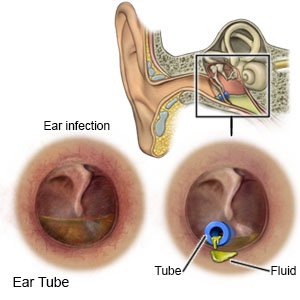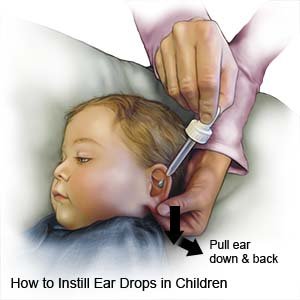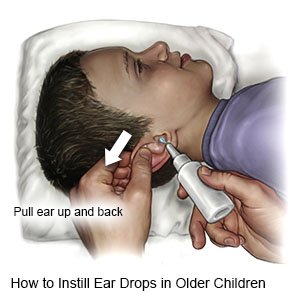Myringotomy with PE Tubes in Children
Medically reviewed by Drugs.com. Last updated on Aug 4, 2025.
AMBULATORY CARE:
What you need to know about myringotomy with PE tubes:
Myringotomy is surgery to put a hole through your child's eardrum. The hole relieves pressure and lets fluid drain from your child's ear. A pressure equalizing (PE) tube will be put through the hole during surgery. The tube is used to keep the hole open and to help drain fluid. Over time, the tube will fall out or be removed by a healthcare provider.
 |
How to prepare your child for surgery:
- Your child's surgeon will tell you how to prepare your child. He or she may tell you not to let your child eat or drink anything after midnight on the day of surgery.
- Tell your child's surgeon about all medicines your child currently takes. The surgeon will tell you if your child needs to stop any medicine for surgery, and when to stop. He or she will tell you which medicines your child should take or not take on the day of surgery.
- Your child's surgeon may check for other ear, nose, or throat problems. Your child may need to have blood and urine tests and x-rays. He or she may also need hearing tests.
- Your child may be given an antibiotic before surgery to fight infection and decrease ear pain. Anesthesia will be given to prevent pain during surgery. Tell your child's surgeon if he or she had an allergic reaction to antibiotics or anesthesia.
What will happen during surgery:
Your child's surgeon may give him or her local anesthesia to numb the ear. Your child may feel pressure or pushing, but he or she should not feel pain. If your child needs to be asleep, he or she will get general anesthesia. Your child's surgeon will make an incision in the eardrum. He or she will drain fluid that is trapped inside the middle ear through this hole. The surgeon will put a small PE tube into the hole. He or she may also put antibiotic drops into your child's ear.
What your child should expect after surgery:
Your child will be taken to a room to rest. If your child was asleep during surgery, he or she will stay there until fully awake. Do not let your child get out of bed until healthcare providers say it is okay. When healthcare providers see that your child is okay, he or she may be able to go home. Medicines may be given to prevent a bacterial infection or to relieve pain and swelling.
Risks of myringotomy with PE tubes:
During surgery, a nerve may be damaged. Damage can decrease your child's ability to taste. After the PE tube is placed, your child may get an infection. He or she may have hearing loss from bleeding or scar tissue. Your child's PE tube may fall out too soon. He or she may need another procedure to put in a new tube. Your child's eardrum may tear from the PE tube. It may not close after the tube is removed. He or she may need surgery to repair the eardrum.
Call your child's surgeon or otolaryngologist if:
- Your child has blood or pus coming from his or her ear.
- Your child has severe ear pain.
- Your child has sudden hearing loss.
- Your child has a fever.
- Your child has changes in his or her hearing.
- Your child has pus leaking from his or her ear.
- Your child is pulling on his or her ear and is irritable.
- Your child has hearing loss or ringing in his or her ear, or feels dizzy after eardrops.
- You have questions or concerns about your child's condition or care.
Related medications
Medicines:
Your child may need any of the following:
- Antibiotics treat or prevent a bacterial infection.
- Prescription pain medicine may be given. Ask your child's healthcare provider how to give this medicine safely. Some prescription pain medicines contain acetaminophen. Do not give your child other medicines that contain acetaminophen without talking to his or her provider. Too much acetaminophen may cause liver damage. Prescription pain medicine may cause constipation. Ask your child's provider how to prevent or treat constipation.
- Steroids help decrease pain and swelling in your child's ear.
- Do not give aspirin to children younger than 18 years. Your child could develop Reye syndrome if he or she has the flu or a fever and takes aspirin. Reye syndrome can cause life-threatening brain and liver damage. Check your child's medicine labels for aspirin or salicylates.
- Give your child's medicine as directed. Contact your child's healthcare provider if you think the medicine is not working as expected. Tell the provider if your child is allergic to any medicine. Keep a current list of the medicines, vitamins, and herbs your child takes. Include the amounts, and when, how, and why they are taken. Bring the list or the medicines in their containers to follow-up visits. Carry your child's medicine list with you in case of an emergency.
Eardrops
may be given. Follow the instructions for putting in the drops based on your child's age.
 |
 |
Care for your child's ears:
Gently use a tissue to remove fluid leaking from your child's ear. Do not use cotton swabs in your child's ear. Ask how to clean your child's ear after a myringotomy.
Activity:
Your child may not be able to do certain activities, such as swimming. Ask how long he or she should avoid these activities.
Speech testing and therapy:
If your child has hearing problems, his or her speech may be tested. A speech therapist may help your child speak more clearly.
Prevent ear infections:
- Keep your child away from smoke. Tobacco smoke increases your child's risk for ear infections. Do not smoke around your child. Move your child to another area, or ask others not to smoke around your child. Ask your healthcare provider for information if you need help quitting.
- Choose daycare carefully. Daycare increases your child's risk for a cold or ear infection. If your child attends daycare, choose a location that has fewer children.
- Do not use pacifiers. These increase the risk for an ear infection.
- Breastfeed your baby, if possible. Breastfeeding may help prevent ear infections in children.
- Hold your baby when he or she drinks from a bottle. Hold your baby in a partially upright position when you feed him or her a bottle. Do not prop up a bottle.
Follow up with your child's surgeon or otolaryngologist as directed:
You may need to have your child's ear checked. He or she may also need to have the PE tube removed. Write down your questions so you remember to ask them during your visits.
© Copyright Merative 2025 Information is for End User's use only and may not be sold, redistributed or otherwise used for commercial purposes.
The above information is an educational aid only. It is not intended as medical advice for individual conditions or treatments. Talk to your doctor, nurse or pharmacist before following any medical regimen to see if it is safe and effective for you.
Further information
Always consult your healthcare provider to ensure the information displayed on this page applies to your personal circumstances.
